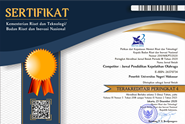The Influence Of Superset Training Model And Circuit Training On Fat Mass Changes And Muscle Mass Increase In Men
(1) University of Education Indonesia
(2) University of Education Indonesia
(3) University of Education Indonesia
(*) Corresponding Author
DOI: https://doi.org/10.26858/cjpko.v13i3.22807
Abstract
The purpose of this study was to determine the difference in the effect of superset and circuit training models on changes in fat mass and increased muscle mass in men. Penelitian ini menggunakan metode eksperimen. The research design used in this study is an experimental The Randomized Pretest-Posttest Control Group design. The sample of this study amounted to 20 men, In this study the sample was selected using the Purposive Sampling technique on members of SOSI SPORT CLUB Bandung City. Collecting data in this study using Karada Scan Body Composition HBF‑375. Statistical calculations in testing the hypothesis were carried out using SPSS 21.0 with Independent Sample T-Test testing to see a comparison between the experimental group and the control group. The results of data analysis and calculations reveal that there is an effect of superset training on reducing fat mass, There is an effect of superset training on increasing muscle mass, There is an effect of circuit training on reducing fat mass, There is an effect of circuit training on increasing muscle mass, There is a difference in the effect of the comparison of superset and circuit training models on fat mass reduction, There is a difference in the effect of the comparison of superset and circuit training models on increasing muscle mass. The conclusion of this study is that the superset and circuit training models have an effect on reducing fat mass and increasing muscle mass in men.
Keywords
References
Clark, J. E. (2015). Diet, exercise or diet with exercise: Comparing the effectiveness of treatment options for weight-loss and changes in fitness for adults (18-65 years old) who are overfat, or obese; systematic review and meta-analysis. Journal of Diabetes and Metabolic Disorders, 14(1). https://doi.org/10.1186/s40200-015-0154-1
Ellis, K. J. (2000). Human body composition: In vivo methods. Physiological Reviews, 80(2), 649–680. https://doi.org/10.1152/physrev.2000.80.2.649
Fields, D. A., Hunter, G. R., Bamman, M. M., Wetzstein, C. J., & Brown, A. (2017). Resistance training increases total energy expenditure and free-living physical activity in older adults. Journal of Applied Physiology, 89(3), 977–984. https://doi.org/10.1152/jappl.2000.89.3.977
Fraenkel, J. R., & Wallen, N. E. (2009). How to Design and Evaluate Research in Education (M. Ryan (ed.); Seventh Ed). The McGraw-Hill Companies, Inc. http://www.ghbook.ir/index.php?name=فرهنگ و رسانه های نوین&option=com_dbook&task=readonline&book_id=13650&page=73&chkhashk=ED9C9491B4&Itemid=218〈=fa&tmpl=component
Frediani, J., Tohill, B. C., Dunbar, S. B., Gary, R., Grossniklaus, D. A., & Higgins, M. K. (2013). Psychological Factors Are Important Correlates of Dietary Pattern in Overweight Adults. The Journal of Cardiovascular Nursing, 25(6), 450–460. https://doi.org/10.1097/jcn.0b013e3181d25433
Horowitz, J. F., & Klein, S. (2000). Lipid metabolism during endurance exercise. American Journal of Clinical Nutrition, 72(2 SUPPL.), 558–563. https://doi.org/10.1093/ajcn/72.2.558s
Lee, J. J., Freeland-Graves, J. H., Pepper, M. R., Stanforth, P. R., & Xu, B. (2015). Prediction of Android and Gynoid Body Adiposity via a Three-dimensional Stereovision Body Imaging System and Dual-Energy X-ray Absorptiometry. Journal of the American College of Nutrition, 34(5), 367–377. https://doi.org/10.1080/07315724.2014.966396
Madureira, A., Rica, R. L., Nolasco, R., Serra, A. J., Antonio, J., Jr, S., & Rodriguez, D. (2012). Effects of circuit-based exercise programs on the body composition of elderly obese women. 551–556.
Markwald, R. R., Melanson, E. L., Smith, M. R., Higgins, J., Perreault, L., Eckel, R. H., & Wright, K. P. (2013). Impact of insufficient sleep on total daily energy expenditure, food intake, and weight gain. Proceedings of the National Academy of Sciences of the United States of America, 110(14), 5695–5700. https://doi.org/10.1073/pnas.1216951110
Marques, A., Peralta, M., Santos, T., Martins, J., & Gaspar de Matos, M. (2019). Self-rated health and health-related quality of life are related with adolescents’ healthy lifestyle. Public Health, 170, 89–94. https://doi.org/10.1016/j.puhe.2019.02.022
Mcgill, S., Weight, L., & Academy, F. (n.d.). Superset Training And HIIT By Shaun McGill.
Nazeer, M. T., Rabia, R., & Gill, S. A. (2016). Impact of Fitness Awareness on Physical Fitness and Exercise ACTIVITIES OF VISITORS IN PUBLIC PARKS. Science International (Lahore), 28(5), 99–102.
Rauner. (2013). The relationship between physical activity, physical fitness and overweight in adolescents: A systematic review of studies published in or after 2000. BMC Pediatrics, 13(1). https://doi.org/10.1186/1471-2431-13-19
Ribeiro, G., Orsatti, F. L., Neder, T., & Júnior, M. M. (2010). Strength training and weight loss Treinamento de força e emagrecimento. 28(4), 337–340.
Sandeep, K. S., Singaraju, G. S., Reddy, V. K., Mandava, P., Bhavikati, V. N., & Reddy, R. (2016). Evaluation of body weight, body mass index, and body fat percentage changes in early stages of fixed orthodontic therapy. Journal of International Society of Preventive and Community Dentistry, 6(4), 349–358. https://doi.org/10.4103/2231-0762.186796
Strasser, B., & Schobersberger, W. (2011). Evidence for resistance training as a treatment therapy in obesity. Journal of Obesity, 2011. https://doi.org/10.1155/2011/482564
Taylor, P., Garbutt, G., Boocock, M. G., Reilly, T., & Troup, J. D. G. (n.d.). Physiological and spinal responses to circuit weight- training. February 2015, 37–41. https://doi.org/10.1080/00140139408963629
Thibault. (2012). The evaluation of body composition: A useful tool for clinical practice. Annals of Nutrition and Metabolism, 60(1), 6–16. https://doi.org/10.1159/000334879
Wang, X., Sparks, J. R., Bowyer, K. P., & Youngstedt, S. D. (2018). Influence of sleep restriction on weight loss outcomes associated with caloric restriction. Sleep, 41(5), 1–11. https://doi.org/10.1093/sleep/zsy027
Westcott, W. L. (2012). Resistance training is medicine: Effects of strength training on health. Current Sports Medicine Reports, 11(4), 209–216. https://doi.org/10.1249/JSR.0b013e31825dabb8
Williams, M. A., Haskell, W. L., Ades, P. A., Amsterdam, E. A., Bittner, V., Franklin, B. A., Gulanick, M., Laing, S. T., & Stewart, K. J. (2007). Resistance exercise in individuals with and without cardiovascular disease: 2007 update: A scientific statement from the American Heart Association Council on Clinical Cardiology and Council on Nutrition, Physical Activity, and Metabolism. Circulation, 116(5), 572–584. https://doi.org/10.1161/CIRCULATIONAHA.107.185214
Article Metrics
Abstract view : 279 times | PDF view : 28 times PDF view : 12 timesRefbacks
- There are currently no refbacks.
Copyright (c) 2021 Kamal Udin Udin

This work is licensed under a Creative Commons Attribution 4.0 International License.
COMPETITOR IS LICENSED BY :
 COMPETITOR is licensed under a Creative Commons Attribution 4.0 International License.
COMPETITOR is licensed under a Creative Commons Attribution 4.0 International License.
COMPETITOR EDITORIAL LOCATION :
![]() Kampus FIK Banta Bantaeng, Jalan Wijaya Kusuma Nomor 14, Rappocini, Makassar, Postal Code 90222
Kampus FIK Banta Bantaeng, Jalan Wijaya Kusuma Nomor 14, Rappocini, Makassar, Postal Code 90222
COMPETITOR IS INDEXED BY















